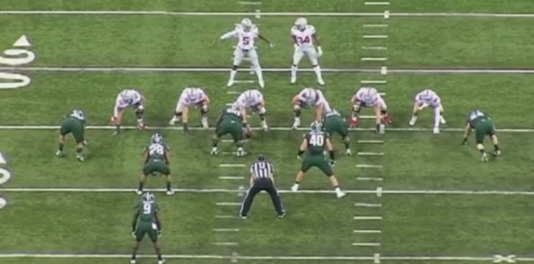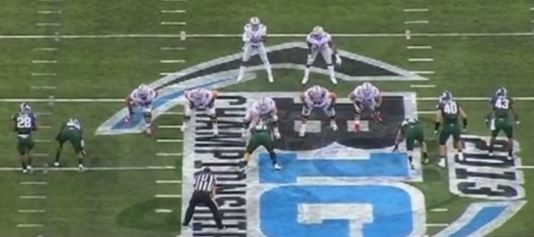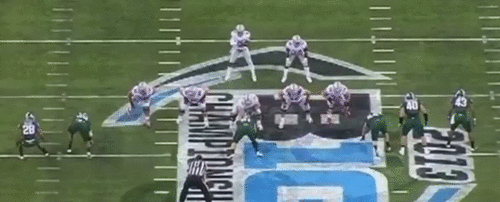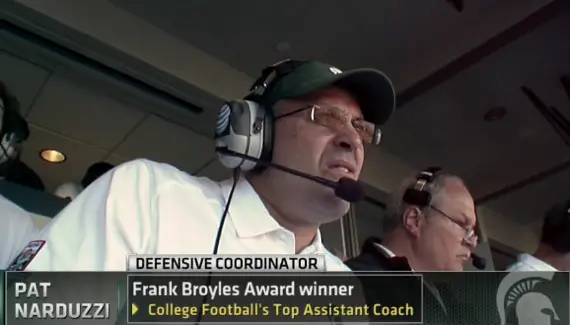September 6th. It’s not that far away.
That’s when Michigan State travels to Eugene to battle the Ducks, and while they are “merely” a Big Ten team, they did beat Stanford, who in turn beat Oregon last year. Schematically on defense, the Spartans have the ability to go toe-to-toe with Oregon – just like the Cardinal did to the Ducks.
This article is a continuation of my last one, which detailed how the Cardinal dismantled Oregon’s pass protection schemes. Here you’ll see exactly how Michigan State attacked Ohio State’s pass protection last year in the Big Ten title game, and you’ll see a lot of similarities compared to last year’s Oregon-Stanford matchup that may make Duck fans shake in their boots a bit.
Michigan State’s Base Defense
Unlike Stanford, Michigan State is in a vanilla look much of the time as a 4-3, Cover 4 team. For those of you who play Madden, Cover 4 is not a prevent defense in the real football world. It’s a terrific run defense, and against traditional I-formation teams, it gets 9 men in the box. It also typically gives a defense one extra defender and there are several small tweaks to amplify it.

Michigan State’s Base 4-2 Nickel Package
Versus some spread looks, they typically end up in a 4-2 or 4-1 box, meaning they either move an outside linebacker out to cover a receiver or they substitute a nickel or dime defensive back.
Now they do some stunting, but this look allows them to play fast against the run. They play Cover 4 (in one of the many variations of it) behind it, and they fly to the football. In “neutral” situations, where it could be a run or pass depending on the game scenario, expect to see Michigan State in this look and coverage.
At this point, the average fan is probably thinking that this is totally different from Stanford’s game plan, as the Cardinal ran a 3-4 defense. They stunted, and they showed different looks.
However, when the defense sits in this look over and over again, the defense knows exactly how the offense will setup their pass protections. Sure, there will be some variations, but that means that Michigan State knows the probable blocking schemes.
That means when they stunt, as we’ll see, it shocks the offense and puts blockers on their heels. It also means that Michigan State can get prime matchups with blockers and overload the weakest parts of the scheme the offense has chosen to use. This is the same core philosophy as Stanford, except in this base look Michigan State does it post-snap completely, where Stanford did it both before and after the snap.

Notice how the blitz gets the center and running back on their heels. The QB can’t step up.
Look at how Michigan State drives both the center and running back into the backfield with their linebackers, thus the QB cannot step up. If you notice, as well, their ends are “caging” the QB, meaning they’re squeezing the pocket while keeping contain. This means that when the QB goes to scramble, they’ll be right there for the sack.

Notice the receiver at the top of the screen who is wide open because of the blitz. This is one of Michigan State’s Zone blitzes, disguised to look just like their Cover 4 look.
There is so much pressure initially right up the middle that the QB misses the wide open receiver at the top of the game film. This type of blitz is lethal to spread play-action passing teams, especially with QB’s who hold the ball a bit long. So while the execution is slightly different (so far) from Stanford’s game plan, Michigan State attacks the same weaknesses with a similar, though different mindset.
Michigan State’s Pass Pressure Defense
I don’t want to sell Michigan State short by calling their defense “vanilla.” They have a nasty stunt package for passing situations, too. It’s a 3-3 look, but it’s not a stack defense like we saw in the early 2000’s. In fact, it’s basically the opposite, as the linebackers usually line up across or near an offensive linemen. What stays the same, though, is their basic Cover 4 coverage principles.

This is used mainly in passing situations to avoid run defense problems.
So there is obviously some running possibilities here, but the offense has no idea what stunt they’re going to get and it’s probably 2nd- or 3rd-and-long. Note that No. 40 starts over the nose and moves around.
In this play, Ohio State runs “half-slide” pass protection that converts to “full-slide.” What does that mean? Full-slide protection is full zone protection to the left of the picture, with the back picking up the edge rusher on the right.

The Offensive Tackle to the overload side usually blocks towards them (notice his first step below). But when the defensive end comes up field and charges inside, he must take the end, leaving the back two on one.
Half-slide means that it’s a mix of man blocking and full-slide, which in turn means that the tackle and the back are man blocking the edge (on the right side of the image). However, if the defensive end comes inside on the offensive tackle, it converts to full-slide. You can tell this is the case because the tackle steps out before stepping in.

The Spartan defensive end on the right of the image, (No. 44) goes up field before stunting inside. This makes sure the tackle takes him and not MSU’s No. 40. The Ohio State running back, needing to make a split-second decision, assumes their tackle will take Spartan No. 40 and pass the MSU No. 44 responsibilities to the Buckeye offensive guard. So that means that the running back takes No. 43, which leaves No. 40 wide open for a big play.
This means Ohio State sent 5 to block 3 to the left of the picture, of which is a very similar problem that Stanford caused for Oregon. In addition, what the Buckeyes did is similar to Oregon’s pass protection scheme used against Stanford, which is why this example is very interesting.
Oregon’s Hope
Oregon’s probably broken this tape down several times, and they know what they’re going to see from Michigan State. Luckily for them, if they can manage to protect, they’re going to hit some big plays down the field. Also, knowing they struggled versus Stanford in similar ways, they’re probably going to have some adjustments. Worst case scenario, if they do struggle in the Michigan State matchup, they’ll be that much more prepared for Stanford.
Besides just the pass protection, the weakness of Cover 4 is play action. While the #1 (or most outside) receivers to each side are usually hard to hit routinely versus Michigan State because their cornerbacks are essentially in a unique version of press man coverage, the out routes and crossing routes by #2 (or slot) receivers are open frequently.

Watch for Keanon Lowe on the Bubble Screen.
Michigan State plays a unique version of Cover 4. Since the Spartans press the #1 receiver with their corners, the MSU safeties and linebackers must respond to the bubble route, and a lot of teams try to use out routes like these on Michigan State. Ohio State did it repeatedly early on but had limited success in many cases. Oregon is definitely a better team in that area of execution, thus interesting to watch for.
Do note that because the Michigan State safeties are taking any vertical routes by the #2 receivers, they have to actually matchup with them in speed and coverage. If a good play action concept holds Michigan State’s linebackers off of Oregon’s slots, then the safeties are one-on-one with Oregon’s more athletic receivers. This strategy has burned Michigan State in the past. The Spartans are very physical against slot receivers, so those players need to be ready to take a hit and not be scared if they get knocked around a bit. They must continue to run their route at full speed.
All of this does, however, work into Michigan State’s ultimate game plan, where they want to get the opposing QB used to holding the ball too long and come after him. The Spartans will want to eliminate the short, quick passes by Oregon and force low percentage deep throws. If the Ducks are able to hit the deep throws or if Michigan State knows that Oregon needs to be throwing on 3rd-and-long, then MSU will go to their pressure package to attack the QB. But if Oregon can cause some personnel matchups by getting their burners on the Spartan’s safeties, this might be a moot point.
Overall, I’m very excited for this matchup and you should be too, as it will be a terrific chess match.
Thanks again for reading. If you’re interested in learning more about this style of defense deployed by Michigan State, check out my e-book on Quarters Coverage. I also cover the topic fairly regularly over at Strong Football.
Coach Curtis Peterson
Indianapolis, Indiana
StrongFootballCoach.com
Curtis Peterson started coaching football in 2005 and he is the founder of Strong Football. He is currently a football coaching consultant for a few teams in the midwest. Coach Peterson welcomes your feedback, please follow him on Twitter at @CoachCP.


